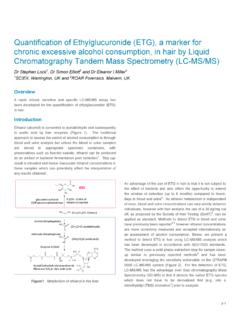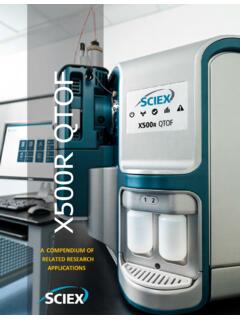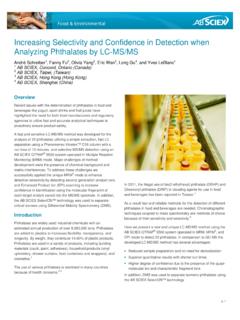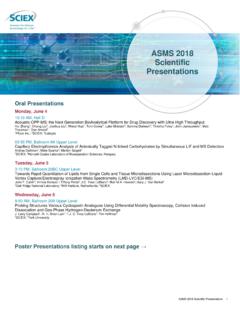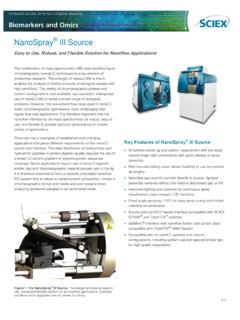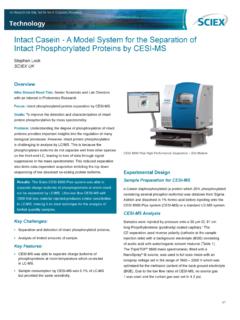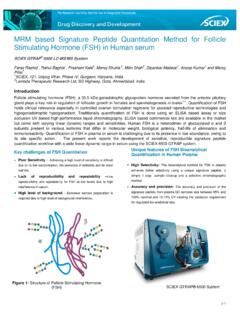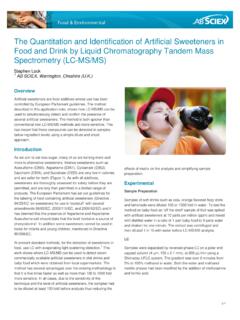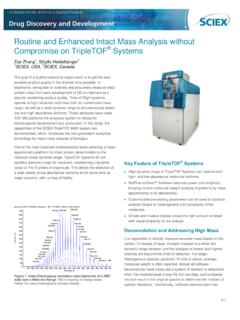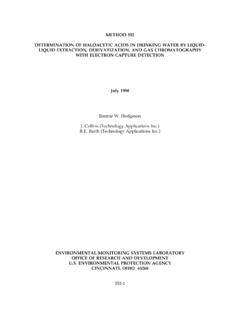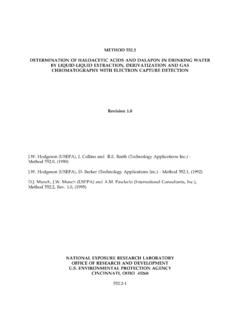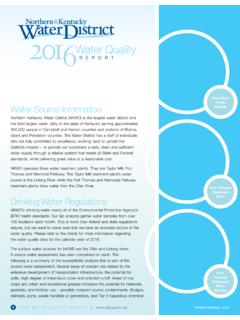Transcription of EPA Method 557: Determination of Haloacetic …
1 P 1 EPA Method 557: Determination of Haloacetic Acids, bromate , and Dalapon in Drinking Water by IC-MS/MS Stacy Tremintin AB SCIEX Foster City, California Overview All drinking water plants in the United States must determine the concentration of disinfection by products in drinking water prior to release. This IC-MS/MS Method follows the current guidelines outlined in EPA Method 557, and was found to be sensitive and reproducible for the quantitation of low-level Haloacetic acids, bromate , and dalapon in drinking and surface Introduction We rely on municipalities to clean drinking water for the prevention of bacterial illness. However, when by-products from the disinfection process are formed in our drinking water, we may experience unexpected health risks.
2 For instance, when chlorine used to disinfect water reacts with organic decaying vegetation, Haloacetic acids (HAAs) form. bromate is formed when disinfecting ozone reacts with naturally occurring bromide. Long term ingestion of bromate or Haloacetic acids may cause Another mechanism for the contamination of drinking water is introduction through runoff. Dalapon, an herbicide used to control grasses in a wide variety of crops, can be introduced to waterways from runoff when used on rights of way. People who drink water containing dalapon in excess of the maximum contaminant level (MCL) for many years could experience minor kidney Haloacetic acids are a family of organic compounds based on the acetic acid molecule (CH3 COOH), where one or more hydrogen atoms attached to carbon atoms are replaced by a halogen (chlorine or bromine).
3 There are nine species of HAAs: monochloroacetic acid (MCAA), monobromoacetic acid (MBAA), dichloroacetic acid (DCAA), bromochloroacetic acid (BCAA), dibromoacetic acid (DBAA), trichloroacetic acid (TCAA), bromodichloroacetic acid (BDCAA), chlorodibromoacetic acid (CDBAA), and tribromoacetic acid (TBAA), however only five acids (MCAA, MBAA, DCAA, DBAA, and TCAA) are regulated with a cumulative legal limit of 60 g/L in drinking water. The MCL for bromate is 10 g/L, while dalapon is Typical approaches to the detection of these compounds require derivatization and multiple extraction steps followed by gas chromatography with electron capture detection. Using ion chromatography as a separation technique prior to detection with tandem mass spectrometry (IC-MS/MS) with the API 3200 system, we achieve a sensitive direct injection Method for the detection and quantitation of nine Haloacetic acids, dalapon, and bromide without time consuming derivatization steps.
4 Experimental Chemicals Deionized water (18M ) was produced in house. Acetonitrile was purchased from JT Baker. Haloacetic acid and dalapon standards were purchased from Sigma-Aldrich. bromate and internal standards of: MCAA-2-13C, MBAA-2-13C, DCAA-2-13C, and TCAA-2-13C were purchased from Dionex. p 2 IC A Dionex ICS3000 system equipped with a Dionex IonPac AG24 x 50 mm and AS24 x 250 mm performed the separation with a column temperature of 15 C. The potassium hydroxide gradient was made online via online eluent generation; a one hour gradient (Table 1) separated the nine Haloacetic acids, bromate , and dalapon from typical matrix ions such as chloride, sulfate, nitrate, and carbonate.
5 Table 1. Ion chromatography gradient Time [KOH] 0 7 7 18 60 60 7 The potassium hydroxide mobile phase was passed through a suppressor prior to its introduction into the mass spectrometer. The suppressor exchanged the potassium counter ion of the mobile phase with hydronium, making the IC effluent into the mass spectrometer predominantly water. Acetonitrile was added post-column at 200 L/min to assist in desolvation, and to provide a makeup flow during periods of diversion. Internal standards of monochloroacetic acid 2-13C, monobromoacetic acid 2-13C, and trichloroacetic acid 2-13C were added for a final concentration of 4 ng/mL. The injection volume was 100 L. MS/MS An AB SCIEX API 3200 system with Turbo V source operated in negative Electrospray Ionization (ESI) mode was used.
6 During periods of matrix elution, the switching valve on the API 3200 system diverted column effluent from the source. The Turbo V source is equipped with a static grounding union. Traditionally this union is installed with a two-port (in/out flow through) piece. In order to introduce acetonitrile to the sample stream, this two-port piece was replaced with the three-port (tee) piece. Operating in this fashion, the eluent composition entering the source is 60% aqueous / 40% organic, which assists in desolvation. During periods of matrix diversion, the acetonitrile flow through the tee acts as a make-up flow to the Turbo V source. The mass spectrometer was operated in Multiple Reaction Monitoring (MRM) mode.
7 Analyte detection was separated into four periods, with temperature and gas settings optimized for compound detection (Table 2 and 3). Table 2. MRM Transitions used for analysis Analyte Q1 Q3 Period 1 MCAA 93 35 MBAA 137 79 bromate 127 111 MCAA-ISTD 94 35 MBAA-ISTD 138 79 Period 2 DCAA 127 83 Dalapon 141 97 BCAA 173 129 DBAA 217 173 DCAA-ISTD 128 84 Period 3 TCAA 1 161 117 TCAA 2 163 119 TCAA-ISTD 162 118 Period 4 TBAA 251 79 BDCAA 163 81 CBDAA 207 79 Table 3. Temperature and ion spray voltage by period IS (V) TEM ( C) Period 1 -4500 400 Period 2 -3500 550 Period 3 -4500 250 Period 4 -4500 350 p 3 Results and Discussion A Method for quantitation and identification of nine Haloacetic acids, bromate , and dalapon was examined to screen drinking and surface water samples.
8 The Method followed the guidelines and met the requirements of EPA Method 557 (Figure 1). Figure 1. Chromatogram of a 10 g/L standard, with the following order of elution: (1) MCAA (2) MBAA (3) bromate (4) dalapon (5) DCAA (6) BCAA (7) DBAA (8) TCAA (9) BDCAA (10) CDBAA (11) TBAA The periods of detection had to be optimized for maximum sensitivity of the analytes, as the response of Haloacetic acids in the mass spectrometer is very sensitive to temperature and ion spray voltage. For instance, a third period had to be defined specifically for temperature sensitive TCAA, whereas other analytes in the Method had much better performance at higher temperatures (Table 3). All analytes showed good linearity with r > over two and a half orders of magnitude in reagent water (Table 5).
9 The detection limit (DL) was calculated from the formula: DL = S x t (n-1, 1- = ) where t (n-1, 1- = ) = Student's t value for the 99% confidence level with n-1 degrees of freedom (for seven replicate injections, the Student s t value is at a 99% confidence level) n = number of replicates, and S = standard deviation of replicate DLs were found between g/L and g/L (Table 5). These detection levels are well below the EPA MCL of 60 g/L and the maximum contaminant level goals (MCLG) established in the National Primary Drinking Water Regulations Stage 1 and Stage 2 for Disinfectants and Disinfection Byproducts Rule. The low DLs allow dilution of real water samples before analysis to reduce possible matrix effects and interferences ( retention time shifts).
10 Precision, accuracy and robustness were demonstrated by injecting all analytes at 1 g/L in reagent water and fortified into the EPA defined laboratory synthetic sample matrix of 20 mg/L nitrate, 150 mg/L bicarbonate, 250 mg/L chloride, 250 mg/L sulfate and 100 mg/L ammonium chloride. Relative standard deviation (RSD) and recovery (REC) were calculated from the formulae: %RSD = Standard deviation of measured conc. x 100 Average concentration %REC = Average measured concentration x 1001 Fortified concentration Method robustness in reagent water was examined for 24 hours; the RSD was less than for all analytes. Samples were fortified into the synthetic sample matrix. During periods of the matrix elution, column effluent was diverted from the mass spectrometer (Figure 2).
